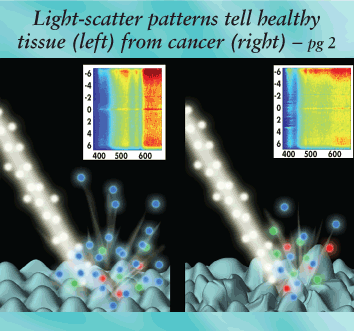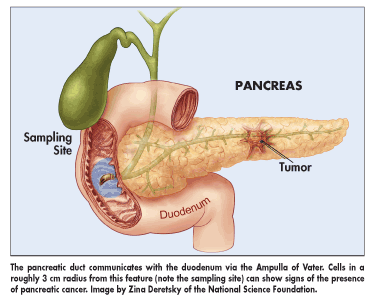Novel optical technology detects treatable pancreatic ca
Using two novel light-scattering techniques to detect optical markers of pancreatic cancer, researchers have shown for the first time the efficacy of a new approach to detecting the disease without biopsy or direct visualization of the organ
EVANSTON, IllinoisUsing two novel light-scattering techniques to detect optical markers of pancreatic cancer, researchers have shown for the first time the efficacy of a new approach to detecting the disease without biopsy or direct visualization of the organ (see cover art). In a 51-participant pilot trial, the relatively noninvasive technology identified all 19 patients in the trial with pancreatic cancer, both those with early- and late-stage disease.

Senior author Vadim Backman, PhD, his former graduate student Yang Liu, PhD, and their colleagues envision the high-tech approach as an eventual screening tool for diagnosing pancreatic cancer in its potentially curable stage I or even precancerous form.
"Using endoscopy and taking biopsies of the pancreas are extremely risky procedures that are not used on asymptomatic patients," noted Dr. Backman, professor of biomedical engineering at Northwestern University. "When a patient becomes symptomatic, it is too late. This creates a vicious cycle that we want to break."
The team reported its results in the August 1 issues of Clinical Cancer Research (13:4392-4399, 2007).
Most pancreatic malignancies originate in the organ's 10-cm-long main duct, which perforates the duodenum. Reaching the duct is both difficult and risky, with a 20% chance of significant complications, including pancreatitis (see Figure).
The pilot clinical trial, conducted with physicians at Evanston Northwestern Healthcare, sought to determine the usefulness of the new technology to diagnose pancreatic cancer by assessing normal-appearing periampullary duodenal mucosa without directly imaging the pancreas.
The Northwestern researchers relied on an extraordinarily sensitive technique developed by Dr. Backman and his laboratory group that uses certain light-scattering effects that can detect changes in the cells lining the duodenum, even cells that appear normal under a conventional microscope. Optical markers represent submicron changes in tissue that result from the presence of a precancerous lesion or cancerous tumor. Examining the duodenum as a surrogate for the pancreas is possible because of a biological phenomenon called the field effect.
"If you have a precancerous or cancerous lesion in the pancreas, even tissue that looks normal and is away from the lesion, including the duodenum, will have molecular and other kinds of abnormal changes," Dr. Backman said.

The researchers compared 2-to-3-mm endoscopically and histologically normal-appearing periampullary duodenal biopsies taken near the pancreatic duct from 19 pancreatic cancer patients and 32 controls. They obtained the patient biopsies within 30 minutes postsurgery from resected tissue or at the time of an endoscopic procedure. Control biopsies were taken at the time of a routine endoscopic procedure.
Using the two complementary optical techniquesfourth-dimensional elastic light scattering (4D-ELF) spectrography and low-coherence enhanced backscattering (LEBS) spectrographyenabled the researchers to examine the tissue structure at levels ranging from macromolecules to whole cells.
The group had validated the technique earlier in colon cancer. They found that the same optical markers that identified colon cancer also identified the pancreatic cancer patients in the new study.
"This new work extends the concept of the field effect, or field carcinogenesis, to the pancreas," said co-author Hemant K. Roy, MD, associate professor of medicine, who participated in both trials. "While the pancreatic cancer research is preliminary, this extraordinarily exciting work offers the prospect of providing an accurate and practical means for screening this lethal malignancy."
Although the light-scattering approach did pick out the 19 patients with pancreatic cancer, it also found tissue-structure makers suggesting the presence of the malignancy in several controls, which resulted in 95% sensitivity and 91% specificity. Whether these findings in the control group represent false positives or individuals who will later develop pancreatic cancer remains an unresolved issue.
"We also found that the diagnostic performance of the technique is not compromised by risk factors in the patients," said Dr. Liu, now a senior scientist at Johnson & Johnson. "The markers don't depend on age, smoking status, or location, stage, or size of the tumor in the pancreas."
The pancreatic cancer screening test is currently in a clinical trial involving about 200 participants at Evanston Hospital sponsored by the National Science Foundation and the National Institutes of Healthwhich also supported the pilot trialto validate the technology's effectiveness.
Newsletter
Stay up to date on recent advances in the multidisciplinary approach to cancer.
Pelareorep Combination Shows Manageable Safety in Metastatic Pancreatic Cancer
January 25th 2025Cohort 5 of the ongoing phase 1/2 GOBLET study evaluated the safety of pelareorep in combination with modified FOLFIRINOX with or without atezolizumab in patients with newly diagnosed metastatic pancreatic ductal adenocarcinoma.